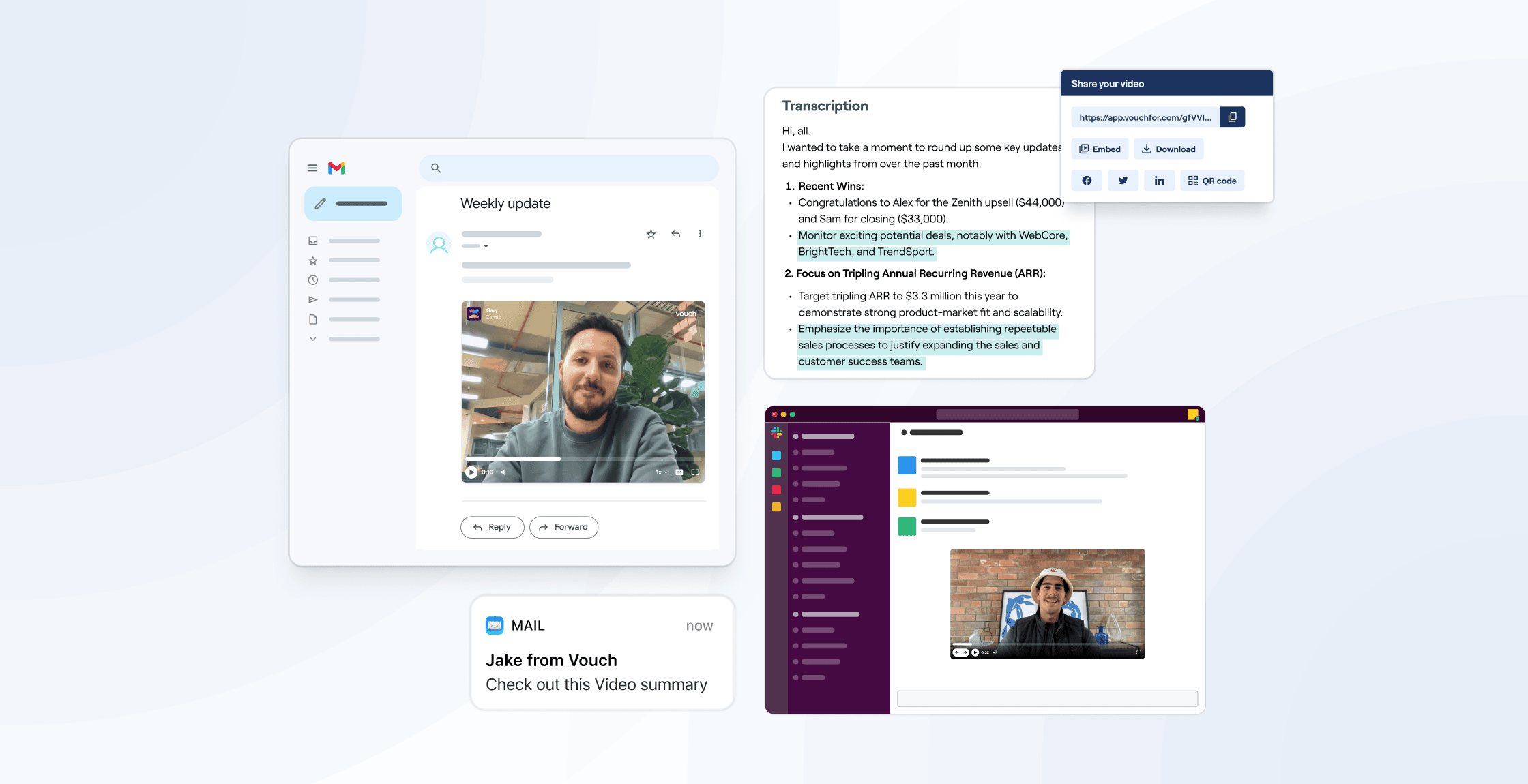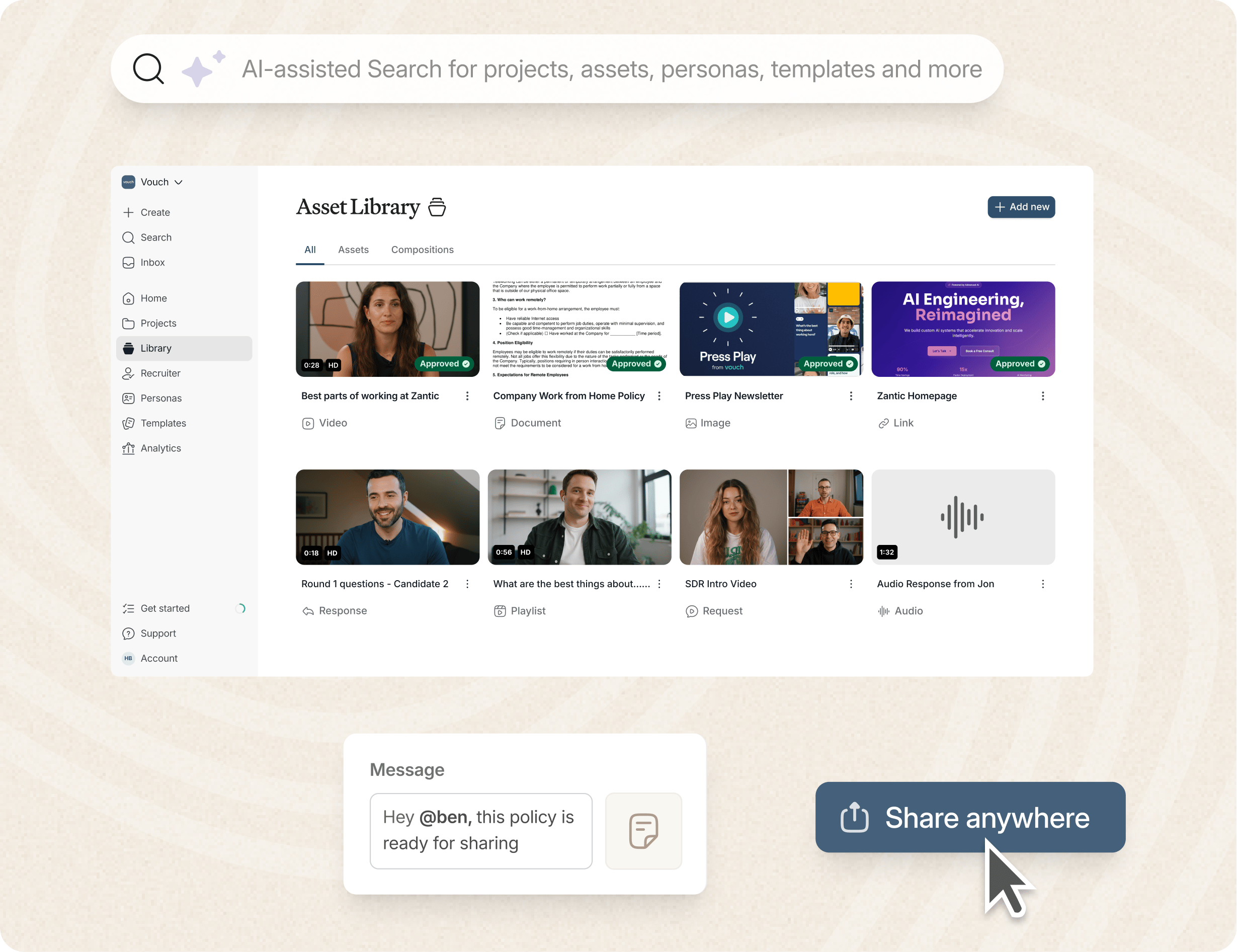
10 Effective Ways To Better Communicate Internally in 2026
Effective internal communication are a vital part of every company, no matter how big or small your business is.
Modern comms strategies and modern communications tools can greatly improve almost every area of your business, help your team better communicate internally and collab, help you build better products and services (and sell them), along with creating a better experience for both your employees and customers.
At Vouch we help a lot of brilliant companies, from Canva to Amazon, to improve their internal communications and employee experience.
So let's get started.
Key Takeaways:
- Effective internal communication is vital for employee and customer engagement, no matter how big or small your company is.
- When you better communicate internally, it boosts employee engagement and has a huge effect on your company culture.
- Building an effective internal communication strategy involves identifying key stakeholders and the ideal communication channels.
- Modern comms tools like Vouch can help you create more personal, authentic internal communications.
What Are The Benefits Of Effective Internal Communications?
When you properly communicate internally, employee engagement and your company culture can skyrocket, literally,
Moreover, your communications tactic are directly related to your company's productivity, helping to provide a smooth flow of information, support team collaboration, help your teams male more informed decisions, and even streamline processes and remove bottlenecks.
For the exec team, your internal communications can directly profits, enhancing employee customer satisfaction and build loyalty across every part of your company.
Let's just say, when you communicate internally effectively, your company can perform like a world-class orchestra, it's a beautiful thing.
What Are The Most Common Ways To Communicate Internally?
There are many ways to communicate within a company, in the sections below we expand on these, but to quickly summarize:
- Face-to-face for personal communications and immediate feedback.
- Phone calls are also a traditional comms tool, but hard to track any information.
- Team meetings help deliver projects and build team collaboration.
- Internal videos that are much more personal than emails, and ideal for remote teams.
- Clear, short emails are a traditional way to communicate that everyone knows how to us.
- Messaging tools like Slack allow for more collaborative real-time team communications.
- Your company intranet can be a great resources for employees.
Let's expand on these comms methods, to help you decide how to better communicate internally:
1. In-person Communications
In-person comms are the most effective method of comms, as you can provide instant feedback and idea, read facial expressions and body language and gestures to help your team understand each other. Face-to-face comms also help to clear up any uncertainties and prevent any misunderstandings by bringing together the right people in the organization. The challenge of course, is that it's not always possible to meet in person or have the time, and it's not always easy to take notes or to-do lists while talking, and that's where other communications methods are superior in a company workplace.
2. Smaller Team Meetings and Huddles
Smaller team meetings are a must when it comes to projects, building teams and sharing updates. Team meetings and morning huddles are a must when it comes to collaboration and skill-sharing too. Just be sure to have someone who can take notes and then share that by email, or record the entire team meeting with video so you can find any missing gems from the meeting.
3. Leverage Internal Videos
We just touched on internal videos, and in 2026 video tools like Vouch are game changers for lots of companies, from SMEs to scale-ups like Culture Amp and even household name companies like Nike.
Internal videos allows for visual storytelling, which is significantly more impactful than text-based communication, and you can simplify complex information through videos, while making it personal.
Executive updates are also highly effective with video, keeping everyone aligned and motivated to do their very best work.
There are just soo many benefits of using video to communicate internally, that it might be best to head to this page if you've been looking to use video for your internal comms.
The AI-enabled workspace for talent teams.
- Unified workspace for talent teams
- Accelerate hiring with AI tools
- Auto-generate polished hiring and employer brand content
- Easily repurpose assets across all channel

4. Clean Up Your Emails
Emails are widely used in companies, but the downfall of email is that they can be overwhelming for employees, especially those who have to focus.
Cleaning up your emails matters, to keep them short and focused. Clearly explain the purpose, provide context, and include any deadlines.
One way to improve company wide comms is by using newsletters - just be sure to keep them short, 1-3 message (or topics) max, and use bullet points or subheadings for easier reading. Also Consider timing and frequency to avoid unnecessary emails.
By improving your company's email clarity and relevance, you can better communicate internally across your entire organization. Email is also perfect for sharing video updates, leveraging the best of multiple comms tools!
5. Messaging Tools like Slack
Slack and similar messaging tools are popular today for internal communication in companies, offering real-time messaging, file sharing, and integration with other platforms, like Vouch video.
Instant messaging apps centralize team comms, allowing for collaboration, updates, and feedback all within one tool.
The trick is, making sure your messaging channels or threads are easy to find and not overwhelming. All too often, an important message or thread can get lost in the chat, and this is where you might need an IM Manager to help if you have a lot of instant messages being shared across your company.
6. Your Company's Intranet Platform
A company intranet can be an incredibly valuable tool, serving as a centralized hub for essential information and resources such as news, policies, training materials, and employee directories.
However, an intranet alone is usually not that effective for communicating internally, as most staff only use an intranet when they need a resource, not to check on updates etc.
To support your intranet, a company newsletter is usually required, so that your people know to check for the latest news and company wide updates.
What Are 10 Strategies for Improving Your Company's Internal Communications?
Now to the good part! To help your company better communicate internally, we've put together 10 strategies. So let's get into them:
1. Establish a Clear(er) Internal Communication Policy
Effective internal communication hinges on a simple yet well-defined policy, outlining your company's overall expectations, procedures, and channels. A structured policy is not designed to get in the way, but indeed empowers employees to communicate confidently knowing which channels they need to use, and for what purpose.
2. Implement The Right Communication Tools and Platforms
Effective internal communication within any company, big or small, requires the use of various tools and platforms. Modern comms tools such as Slack, Microsoft Teams, and Vouch, as well as internal project management software like intranet software, enriches the employee experience and benefits all team members. However, it is important to choose the right tools, such as internal communications software, as they need to be easy to use and highly intuitive.
3. Promote Open and Transparent Communications
As part of your communications policy, promoting open and transparent comms within your organization is a must, and this includes embracing employee feedback, which you can do with tools like Vouch too!
4. Encourage Feedback From Your Employees
We just touched on it, but with open and transparent comms, you need employee feedback. Video is ideal as it helps you "see your employees" so you can read their body language etc, but additionally online surveys, suggestion boxes, or even a feedback area on your intranet can provide the best way for gathering feedback.
Just be sure to make it easy and productive, you need your employees to know they are safe and that their feedback is helpful, no matter what it is.
Encouraging feedback from your employees, including their suggestions for social events, is a great way to improve communication and foster a positive work environment.
5. Regularly Update Employees on Company Goals and News
Keeping your employees informed is essential, and your company updates on your company goals and achievements help employees stay and feel connected. Show your employees "how" their work fits into the bigger picture, while promoting transparency, diversity and inclusivity at all times.
6. Leverage Team Building Activities to Strengthen Relationships
Team building is crucial for all of your team relationships and can lead to greater profitability. Activities build trust, improve communication, and enhance collaboration - and they can be super simple.
You can also kicks start your team activities by helping your wider team get to know all of your employee with strategies like spotlight questions, and you might like these 25 Spotlight Questions to ask employees. By investing in team building activities, you are laying the groundwork for a diverse and inclusive workplace, which has been shown to result in better financial performance and greater profitability.
7. Provide Communication Skills Training
Of course, not everyone is a great communicator. Investing in communications training, such as teaching effective listening and issue resolution can be a brilliant way to improve your overall company communications. We'll put together a list of amazing internal communication training companies soon, so stay tuned!
8. Implement Visuals and Multimedia for Better Engagement
To engage your team effectively, incorporate visuals and multimedia into your communications. Pictures, videos, and interactive tools enhance communications significantly. For example, according to a Wistia study, videos up to 2 mins long have an ave retention rate of 60%.
However, for text-based messages, the average reader spends approx. 37 seconds reading an article or blog post. The engagement time different between video and text is massive! If you'd like to learn more, you'll love this article: Internal Communications Video Ideas, 11 Ways To Inspire
9. Recognize and Celebrate Achievements Within Your Company
Recognizing and praising team and employee achievements helps to create a positive workplace culture and boost motivation. Celebrating victories openly can also help improve retention rates, so be sure to add "celebrate" to your company's communication policy.
10. Schedule Regular Check-Ins
When it comes to meetings, you always need to be sure that you are not wasting valuable team time and resources. However, you need to consider the underlying benefits, and regular checkins are a must for larger or hyper bust companiues where employees can go weeks without checking in with management or even their teams. So be sure to add regular check-ins to your company policy too.
How Do You Build an Effective Internal Communication Strategy?
To communicate internally, transparency and engagement are key, so consider these five steps:
- Identify Key Stakeholders: Department heads, team leaders, and all employees are stakeholders. Recognizing your communications leaders is the key.
- Choose The Right Communication Channels: Tools such as meetings, newsletters, video, messaging platforms etc, there are a lot, so you need to choose the right channels for your company.
- Set Clear Goals: To communicate internally effectively, you need to establish measurable targets aligned with your overall business goals.
- Develop a Content Strategy: Producing engaging and valuable content for employees is a massive part to communicate internally effectively.
- Encourage Open, Authentic Communication: Promote an open culture that welcomes feedback and ideas through meetings, surveys and focus groups.
What Are The Common Challenges in Internal Communication?
When looking at how to communicate internally, it's also good to know your weak points. These issues can include:
- Information overload, especially through channels like email that can quickly "stack up".
- Communication gaps across your team, including your remote workers and people on the road.
- Aligning internal and external communication, setting a tone and tools that work across both.
Overcoming Information Overload
Information overload happens when employees get too much information, making it hard to focus on key messages and tasks. You can go a long way to solving this by simplifying communications to focus on vital info, like training your team to send shorter emails, or using IM and video to communicate more clearly through various channels. With a wealth of information available, it's important to organize it effectively in order to overcome information overload. This can be achieved by using categories, tags, and a knowledge base with powerful search functions to make information easier to find and access.
Bridging the Gap in Remote Work Communication
To effectively communicate internally, you also need to know where the gaps are.
This is where yoru communicaions policy comes in, and also where both internal and external channels need to have consistent messages. Then, it's absolutely vital to bridge the gap to remote workers and those on the road, no matter their location, through a well-planned internal communication plan led by internal communication professionals.
This internal communications strategy, also known as the Internal Communication Plan, is crucial in ensuring that important messages are effectively delivered to all employees, especially those who may be working remotely or on different schedules. The plan helps to motivate employees and encourage collaboration by clearly outlining goals and tactics needed to achieve them.
Using The Wrong, Or Too Many Communication Tools
Using the right tools to build a more connected workforce is everything, and often, companies implement tools that are a) too complex and non-intuitive or b) have too many ways of communicating, so that important communications get lost.
Integrating AI Too Soon
At Vouch we use AI to make video editing faster and more efficient, it's brilliant technology! But when it comes to communicating internally, we have seen a lot of companies implement AI too soon, and rely on chatbots and other technology before it's mature enough, and often not personal enough. To communicate internally effectively, it's often best to keep it simple and personal.
FAQs
What is meant by internal communication?
Internal communication refers to the sharing of information within an organization, ensuring that employees are well-informed and connected. It plays a crucial role in building a positive company culture, facilitating effective employee communication, and aligning with the overall business strategy.
What are the best practices for internal communication?
Best practices for internal communication include developing a comprehensive communication strategy, utilizing various communication channels, such as company newsletters and open communication channels, and fostering a culture of open and transparent communication within the organization.
How can technology help improve internal communication among employees?
Technology can improve internal communication among employees by providing tools and platforms that facilitate effective communication, streamline processes, and enhance the employee experience. Modern technology like Vouch can go a long way to improving collaboration, and information sharing within your company.
What are the four types of internal communication?
The four types of internal communication are management communication, team communication, face-to-face communication, and peer communication. Each type serves a specific purpose in disseminating information within the organization and fostering effective communication among employees and external stakeholders.
How do you measure the effectiveness of your internal communication?
Measuring the effectiveness of internal communication can be done by setting clear goals, defining key performance indicators (KPIs), and gathering feedback from employees. Regularly assessing the impact of internal communication efforts against business goals and KPIs helps organizations evaluate the success of their communication strategy and make informed improvements.
What role does your leadership team play in your internal communication?
Effective internal communication starts at the top. Your exec team and team leaders play a vital role in communicating the company's vision, goals, and values to inspire employees and ultimately drive business performance. By effectively communicating with your team (exec communications), your leaders can create a sense of trust, motivation, and alignment towards your company's objectives and contribute to overall business performance through an effective internal communications plan. This includes not only upper management, but also front-line employees who must understand and demonstrate the company's key values for the communication strategy to be effective throughout the entire company. A strong internal communication strategy, including measurable goals and regular communication, is crucial for keeping employees interested and engaged, making them feel like they are a vital part of the company's mission and not just meaningless cogs in a machine.
What are the common pitfalls in internal communications?
Common pitfalls in internal communication include lack of policy and strategy, over-reliance on emails, and neglecting the power of face-to-face interactions. It's important to address communication barriers and encourage open and transparent communication throughout yoru entire organization.
How do you make your internal communications more engaging?
In a few words, try using video! We think you'll love Vouch.
Conclusion
To effectively communicate internally within your company, you really need to have a clear policy that covers what channels to use, and when to use them. Once you know this, you can then start implementing modern comms tools like Video and IM tools, and importantly measure their success. By making your internal communication a priority, you can have a connected and motivated team that helps achieve long-term growth and financial success.
Implement Better Internal Communications Tools With Vouch?
Loved by companies like Canva, Nike, Cisco, HubSpot, Amazon, and more, tools like Vouch make leveraging video in your business remarkably easy.
Be sure to book a Vouch demo today and chat with a video content expert.
You might also like

Elevate Your Brand Today With Vouch
Discover how Vouch can accelerate talent acquisition while helping you stay on-brand.





